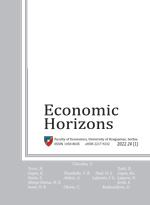PERSPECTIVES OF THE INTERNATIONAL MONETARY SYSTEM
Nenad Jankovic
Faculty of Economics, University of Kragujevac, Kragujevac, The Republic of Serbia
During the 20th century, the dollar gained the status of the world’s most important currency. Therefore, the Bretton Woods International Monetary System was based on the dollar. However, in the 1970s, the situation changed significantly - demand for dollars declined, the currencies of the most important European countries became convertible, the volume of international trade increased greatly, international capital flows were liberalized, the external convertibility of the dollar to gold was abolished, and the currencies began to fluctuate. In this way, the original Bretton Woods international monetary system ceased to exist. In addition to the changes, the functioning of the international monetary system is greatly impacted by the fact that the United States recorded an increasing amount of current account deficits from year to year and, in the 1980s, moved from the position of the net creditor to that of the net debtor, that the euro was created on the soil of the EU and that China became the world’s largest exporter and one of the largest (if not the largest) world economies. For this reason, the theoretical assumptions of the international monetary system are systematized in the paper, the role of other world currencies is examined, and the question of why the dollar continues to be the dominant world currency is answered.
Keywords: Bretton Woods International Monetary System, dollar, euro, yuan, world currency
JEL Classification: F31, F32, F33, F62, F65




